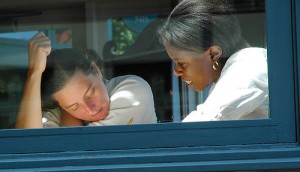Motivation By Seeing Impact


Adam Grant set out to discover a unique factor that contributes to how successful people continue working long-term without burning out. So much depends upon how we relate. Outside of hard work, passion, talent, and luck, how do the ways in which we collaborate, network, influence, and lead result in greater success and impact?
In his remarkable book Give & Take: A Revolutionary Approach to Success, the “single highest-rated teacher at The Wharton School” challenges the assumption that givers are chumps when it comes to success. His core discovery is this: People with genuine high regard for others’ interests who also preserve their own interests have the highest impact – more than selfish takers and more than selfless givers. They are what Grant calls otherish givers.
Grant focuses especially on teachers in the chapter “The Art of Motivational Maintenance.” It’s here that I think we consultants, teachers, coaches, entrepreneurs, and writers can benefit. If you follow Tracking Wonder, then meaning more than money likely drives you, but you’re also not a chump when it comes to earning a sustainable livelihood.
“Teachers are vulnerable to giver burnout,” Grant notes, “because of the unique temporal experience that defines education. Even though teachers interact with their students on a daily basis, it can take many years for their impact to sink in.”
That’s true for artists, authors, and entrepreneurs, too. It takes years – sometimes after one’s death – before the impact of art or business is realized or appreciated.
So, when you’re “in the trenches” of a classroom, creative work, or a start-up, what keeps you going? How do you keep spreading the good creative medicine even when your efforts feel thankless?
In study after study, situation after situation, Grant observed that the teachers, entrepreneurs, and creatives who see frequently that their work makes a meaningful difference in others’ lives feel motivated to continue having even greater impact.
Perhaps this fact points to one reason solo artists and writers and designers – and others whose creative work requires considerable solitude – teach. The difference we make is palpable and yet, as the findings above indicate, it’s still challenging for us to perceive what difference we make.
Here are five ways you can start seeing impact with your own creative medicine.
Prototype.
Don’t save up your creative reserves for your magnum opus or your monumental first exhibit or your ostensible first book-runaway bestseller.
- A thoughtful blog anchored with a certain point of view and persona.
- A free class or talk.
- A live “circle” or meet-up to hold conversations on a topic related to what you create or offer.
- An eBook before the big book.
Work for long-term growth.
If you are a consultant, coach, or teacher, create situations and packages that require 3-month, 6-month, or longer term commitments between your clients and you. This way, you hold yourself accountable for witnessing and measuring growth. Yoga teachers of 90-minute studio classes and one-off workshop leaders can get burnt in the long term because there are limited chances to see impact.
When I work with an organization or an individual, I prefer a 3-, 6-, or 12-month commitment for these reasons.
Work with groups.
My life as a consultant and teacher amplified twenty-fold this year when we launched the Your Captivating Book Mentorship Program. Why? Because my team and I had set up an educational design with webinars, manuscript reviews, live call mentoring, VIP Days, and more that made a palpable difference. And they made a difference in each other’s lives and continue to propel each other toward their dream horizons. (With no faculty meetings.)
Chunk giving.
Grant uses this idea. It’s the idea – a key tenet of Tracking Wonder – that you act with intention and with shaped time. You deliberately “set aside” your time to give. At the very least, become more aware of when you’re giving or over-giving. Similarly, if you work in an environment that demands constant giving, shape time alone for rejuvenation and self-care.
Show your team their impact.
I try to include in every team meeting some direct indication of what a team member’s behind-the-scenes work is doing for our clients that in turn affects some patch of the planet. Grant notes that several organizations now connect their employees with the people whose lives they affect. I advised a small publisher to do likewise with his underpaid, over-worked staff. A simple live event put his staff in contact not only with the authors and designers whose work their magazine showcased but also – and perhaps more importantly – the readers whose lives & minds directly benefited.
Let me know what you think in the comments here. How do you see impact in what you, your creative work, or your business does? How does your engagement online as well as live & local help you see impact?
Jeffrey